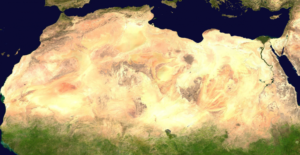by K. Richard, Aug 1, 2022 in NoTricksZone
If wetter is warmer and drier is colder, the modern Saharan climate suggests we are not in a warm period.
It is common knowledge that warmer temperatures are associated with wetter, greener climates, and cooler temperatures are linked to droughts, browning, crop failures, etc.
For example, in the continental US there is a “robust association between pan-CONUS drought events and cold tropical Pacific conditions” (Baek et al., 2019). Again, cooling sea surface temperatures are the “principal driver” of drought across the US.
…
by P. Gosselin, January 16, 2019 in NoTricksZone
Recently, CO2 Science brought up a paper in Nature Communications.
Using satellite images, Venter et al. 2018 found an eight percent increase in woody vegetation in sub-Saharan Africa over the last three decades, underscoring the global “greening trend”.
…
According to Wikipedia, the Sahara covers a vast area of some 9.2 million square kilometers. Eight percent of that translates into more than 700,000 square kilometers. That’s an area that’s almost as big as Germany and France combined! This is profound.
In other words, it’s well over 10,000 Manhattans!

Recent study by Venter et al finds that the Sahara has shrunk by 8% over the past three decades. NASA image, public domain.
…
by P. Homewood, April 1, 2018 in NotaLotofPeopleKnowThat
The green shoots of recovery are showing up on satellite images of regions including the Sahel, a semi-desert zone bordering the Sahara to the south that stretches some 2,400 miles (3,860 kilometers).
Images taken between 1982 and 2002 revealed extensive regreening throughout the Sahel, according to a new study in the journal Biogeosciences.
The study suggests huge increases in vegetation in areas including central Chad and western Sudan.
La géologie, une science plus que passionnante … et diverse

